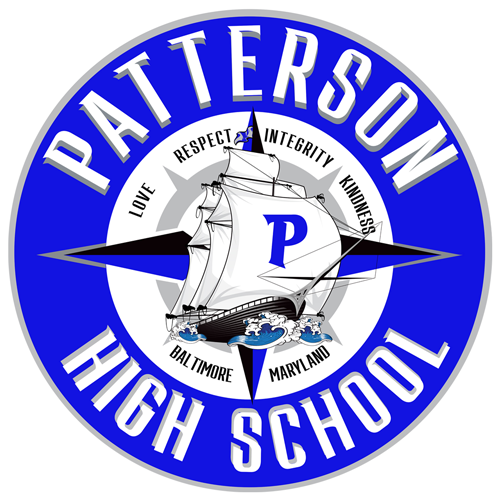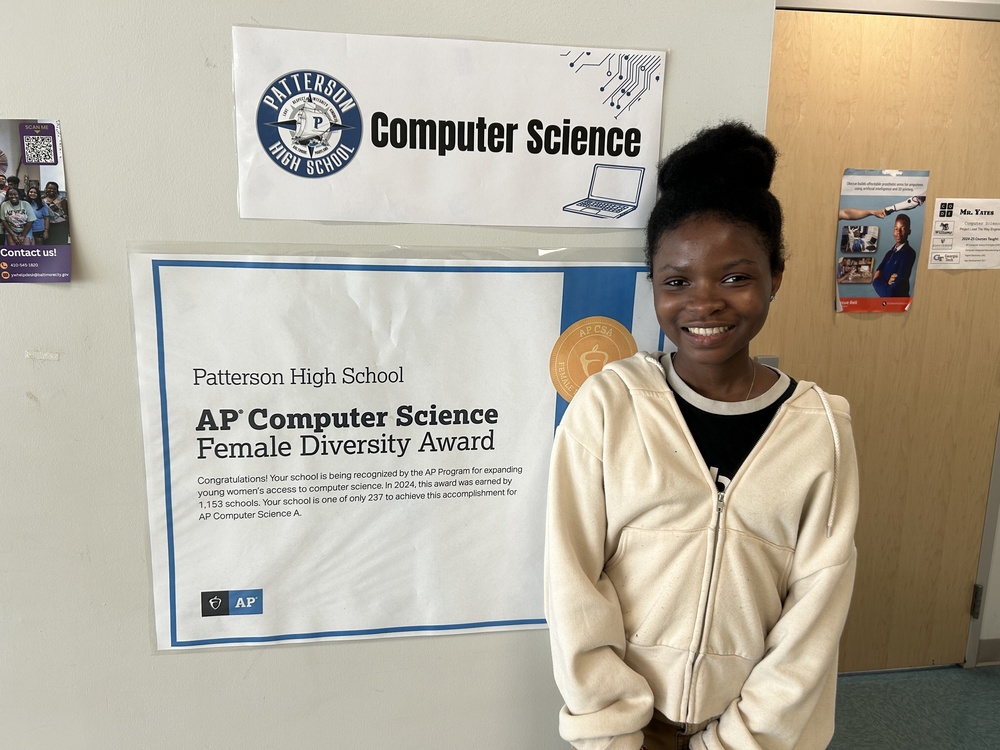Someday, cigarette smokers may be able to log into an app on their Android cell phones to get tips and support to stop smoking. Another app could help Baltimoreans who have food to donate use Google Maps to locate neighbors or organizations that can use the donation.
 Those are just two of the capstone projects being worked on in Nick Yates’ AP Computer Science Development course at Patterson High School (Patterson). It’s an award-winning class: along with Western High School (Western), Patterson has earned the College Board AP® Computer Science A courses. Western won an additional Female Diversity award.
Those are just two of the capstone projects being worked on in Nick Yates’ AP Computer Science Development course at Patterson High School (Patterson). It’s an award-winning class: along with Western High School (Western), Patterson has earned the College Board AP® Computer Science A courses. Western won an additional Female Diversity award.
The Female Diversity Award honors schools that have “either reached 50% or higher female exam taker representation in one or both AP computer science courses, or a percentage of female computer science exam takers that meets or exceeds that of the school’s female population.”
Two other City high schools—Renaissance Academy and Coppin Academy—won the Computer Science Female Diversity Award for Computer Science Principles.
In capstone projects, students apply what they’ve learned in previous courses to develop a creative solution to a real-world problem. The semester-long activity, either individually or in teams, allows students to showcase and test their proficiency while developing research and planning skills—all important talents in preparation for their college experience.
Annaelle is developing an app to help people stop smoking, and Liliana is creating an app for food insecurity. The two seniors are enrolled in the Computer Science Career Technology Education (CTE) pathway at Patterson. 
Through City Schools' Career and Technical Education Pathways, students pursue sequential classes and internships in their area of interest, building foundational knowledge to prepare for college and career success. They also earn industry-recognized certification, increasing their earning potential and distinguishing themselves in college and job applications. Thirty pathways are offered throughout City Schools.
Annaelle’s interest in computer science began in middle school. “I like patterns,” she says. “It’s fun to see how coding works and then animate something through an algorithm.”
Annaelle intends to pursue a career in information technology and credits the Patterson Career Pathway with “previewing what the industry is like. I want to know how software and apps work,” she says, "especially understanding data breaches and how information is analyzed.”
Annaelle’s journey will continue at the University of Maryland, College Park, in the fall.
Like Annaelle and their classmates, Liliana’s app is her capstone project for the spring semester. She, too, enjoys understanding how systems, especially social media apps, work. “I like using computer science to solve problems,” she says.
After students brainstorm ideas for what they’d like an app to do, they develop sketches and a plan using the curriculum from code.org, a nonprofit focusing on increasing participation by young women and students from other underrepresented groups. Mr. Yates then connects each student to a “client,” a member of the Patterson community who provides practical advice. For example, Annaelle met with a Patterson health teacher for her stop-smoking app, and Liliana spoke with the Community School Coordinator from the Y of Central Maryland.
 For their capstone projects, girls in the Computer Science Pathway at Western are developing equally valuable apps. One student is creating a program to help low-income families locate resources, while another is working on an app to provide emotional support for single parents.
For their capstone projects, girls in the Computer Science Pathway at Western are developing equally valuable apps. One student is creating a program to help low-income families locate resources, while another is working on an app to provide emotional support for single parents.
“The student recognizes that parents are under a lot of stress and anxiety,” says Western teacher Jen Smith. “She wants to help them be their best selves and show up for their kids.”
The Western classroom for the 25 computer science pathway students feels like a software firm, says Smith. “There’s lots of collaboration, brainstorming, and feedback. We’re preparing them for the workplace and with the skills they need for any career in IT. They’re also building confidence in their math skills and are getting higher math scores because of this experience.”
There’s additional support for female students pursuing STEM. At Patterson, for example, girls participate in a monthly mentoring meeting. They’re often introduced to professionals working in STEM; recent speakers have been from Northrop Grumman and the Baltimore City Department of Transportation. They also take field trips to STEM seminars and related worksites, most recently a behind-the-scenes tour of BWI Airport.
The impact of the Pathway and the classes on girls is evident to Smith and Yates. Says Yates, “We’re not only preparing students for college majors and high-paying careers, but they’re learning tools to solve problems in their community. Being literate means having the technical skills that will be an asset for any job and being a good citizen of the 21st century.
Jen Smith agrees: “Computer science is for all. We’re breaking barriers and social stereotypes of what computer science looks like. We’re looking at computer science through a cultural context; it impacts all lives.”

